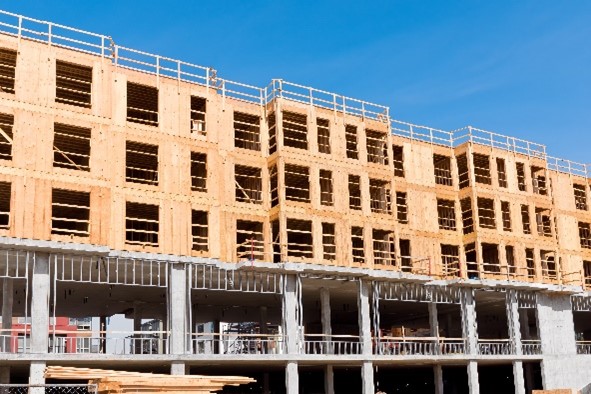This edition will delve into the challenges facing multifamily investors amidst tightening lending conditions and volatile capital markets. While the fundamentals in major Sun Belt cities remain strong, multifamily investors and developers nationwide need help to secure loans due to rising interest rates and tightening lending standards. Bank deposits remain stable, but increasing caution in the commercial real estate lending space persists.
Multifamily Investors Face Tightening Lending Conditions Amidst Volatile Capital Markets

Sun Belt Markets & Fundamentals Remain Strong, But Challenges Persist
The multifamily property market in major Sun Belt cities remains fundamentally strong, but multifamily investors nationwide are grappling with challenging lending conditions due to the broader upheavals in the U.S. capital markets. Factors such as rising interest rates, tightening underwriting standards, and the aftermath of a handful of bank collapses have led to a significant reluctance among lenders to transact in the current environment.
Depleted Lending Volumes
The Federal Reserve’s eight interest rate increases, totaling 500 basis points over the past 16 months, have significantly impacted multifamily lending. However, it is more than just the interest rate hikes; owners are also contending with substantial increases in property taxes and insurance costs across the county, leading to a lack of deals and transactions across the board.
Bank Reservations
Major banks are cautious about originations and maintain higher reserves to mitigate potential losses from office loan defaults, which are expected to increase in the next 12 to 18 months. Recent collapses of regional lenders have further exacerbated banks’ wariness, causing them to adopt defensive stances in the current environment.
Reluctance to Transact
Lenders have shifted from an offensive to a defensive playbook, focusing on preserving capital rather than taking additional risks. Some lenders prefer not to make loans at all to avoid potential downsides, highlighting the cautious climate in the market.
Anemic Acquisitions Market
The acquisitions market is experiencing a slowdown, with a 70 percent decrease in investment sales nationally year over year. Most transactions are now limited to refinances, while acquisitions, apart from a few forced sales, currently remain stagnant.
Construction Lending Drought
The construction lending market has significantly dried up, even for preferred asset classes like multifamily properties. Experienced developers are finding it challenging to secure financing for new projects, indicating the severity of the liquidity crunch.
Difficulty for New Borrowers
It is particularly challenging for new borrowers to establish relationships with banks and secure loans. Banks prefer working with existing clients or other banks, and if a borrower has a well-established relationship, obtaining financing is extremely tough right now.
Bridge Loan Challenges
Borrowers who previously opted for bridge loans face difficulties transitioning to permanent financing structures. This situation puts additional pressure on deal volume.
Leverage Reduction and Full Recourse
Lenders are scaling back leverage by 10 to 15 percent and requiring developers to bring in deposits to mitigate risk. Additionally, previously non-recourse deals are now offered with partial or full recourse, making it harder for construction deals to be economically viable.
Unconventional Approach
Some lenders are shifting focus from providing loans to gathering deposits, which could improve their bonuses. However, this approach requires borrowers to sweeten the deal for lenders, and it only sometimes leads to more deal volume or velocity.
Lenders Exercising Caution
Multifamily investors are navigating a challenging landscape characterized by tightening lending conditions and reduced deal volumes. With the market moving from a growth phase towards an uncertain future, lenders are exercising caution, favoring defensive strategies to protect their capital.
Apartment Developers Seek Alternatives to Bank Loans for Construction Financing

Challenges Persist Securing Construction Loans
Apartment developers face challenges securing construction loans from traditional banks due to rising interest rates and several recent bank failures. As a result, they are exploring alternative financing options to fund their new projects.
Banks Scaling Back
Several banks are reluctant to provide construction loans due to concerns about existing real estate debt and exposure, mainly caused by the office sector and the volatile capital markets. As a result, they have become more conservative, offering lower loan-to-cost ratios and higher interest rates compared to previous cycles.
Changing Capital Stack
Previously, developers heavily relied on banks for construction loans covering 75% of development costs. However, the capital stack has evolved, with recent construction finance offers providing 55% to 65% loan-to-cost ratios and higher debt service coverage requirements.
FHA Loans
Developers who can wait for financing are exploring Federal Housing Administration (FHA) programs. FHA construction loans offer relatively large loan amounts with fixed, low-interest rates. Once the property is leased up, the loan converts into a 40-year, fully amortizing permanent loan. Though FHA loans take an average of 12 months to close, they offer stability and lower interest rates than bank financing. FHA construction loans offer non-recourse financing with fixed interest rates based on 10-year Treasury bond yields. Though the loan process takes time, it provides stability in a market with fluctuating short-term interest rates.
Private Debt Funds and Commercial Mortgage REITs
Private debt funds and commercial mortgage REITs are stepping in to provide senior construction loans with generous leverage. While their interest rates are higher than current bank financing, they offer an alternative to developers needing construction financing.
Mezzanine Financing
Some developers rely on small loans at high-interest rates from banks and use mezzanine financing from lenders like debt funds to bridge the gap in their capital stack.
Private Debt Funds
Debt funds provide developers with high-leverage loans more quickly than traditional banks. While interest rates may be higher, they offer a viable solution for developers needing timely financing.
Apartment Construction Continues
Despite financing challenges, developers are still proceeding with new multifamily projects. They expect relatively little competition for senior debt once their buildings are completed.
Developers Adapt to Evolving Market Conditions
Apartment developers navigate a changing financing landscape as traditional banks scale back on construction loans. In response, they are exploring alternatives, and despite the challenges, developers remain committed to new construction and are finding ways to adapt to the evolving market conditions.
U.S. Bank Deposits Stable, But Commercial Real Estate Faces Challenges

Delinquency Remains Low for Now
U.S. bank deposits have remained relatively stable in recent years despite rising concerns about liquidity. However, lenders show increased caution and reduce exposure to commercial real estate (CRE) loans. While delinquency rates on commercial mortgages remain low, a recent uptick has led to speculation about the impact on outstanding real estate debt.
Stable U.S. Bank Deposits
Despite liquidity concerns, U.S. bank deposits have remained broadly stable over the past few years. This stability indicates a level of confidence among depositors in the banking system.
Bank Lenders’ Involvement in Commercial and Multifamily Mortgages
As of the first quarter of 2023, banks account for about 40% of commercial and multifamily mortgages. However, this figure is expected to increase significantly, with more than half of the maturing loans projected to be backed by bank lenders by 2026 and 2027.
Low Delinquency Rates, But Recent Increases
While delinquency rates on commercial mortgages remain low, there has been a recent uptick in delinquencies. This trend reflects the impact of tighter credit conditions on the commercial real estate market.
Impact on Real Estate Deal Volume
The tighter credit conditions and higher borrowing costs have affected real estate deal volume. MSCI Real Capital Analytics data indicates a 70% decrease in real estate deal activity over the past few quarters.
Distress Balance Across Sectors
Among the five main sectors, retail and office have the highest share of outstanding distress balance. These sectors are experiencing challenges in the current real estate market.
Lenders’ Approach to Mitigating Risk
Lenders proactively manage risk by selling portfolios backed by high-quality core assets with short durations and floating rates. Depending on market conditions, they may subsequently divest non-core assets in the future.
Moody’s Analytics Scenario Analysis
Moody’s Analytics conducted a scenario analysis, considering leverage, rent growth, and cap rates. The analysis suggests that the potential risk to banks from commercial real estate is now more mitigated than before the global financial crisis.
Low Overall Exposure of Banks to CRE
Banks’ exposure to commercial real estate, particularly among the largest banks, remains low overall for the time being. This lower exposure provides some level of protection against potential market fluctuations; however, lenders remain cautious.
Prudent Risk Management Top of Mind
U.S. banks have maintained stable deposits despite liquidity concerns, offering some level of reassurance about the banking system’s health. However, the commercial real estate sector faces headwinds, with increasing delinquency rates among office and retail assets and a slowdown in transaction volume. Lenders are adopting cautious strategies to mitigate risks and considering divesting non-core assets. While potential risks to banks are now considered more manageable than during the global financial crisis, ongoing monitoring, and prudent risk management are still top of mind.
42 Broad: Now Leasing, World's Largest Market-Rate, Phius-Certified Multifamily High-Rise Offers Sustainable Luxury Living
Sustainable Features and Diverse Amenities
Leasing has begun for 42 Broad, the world’s largest market-rate, Phius-certified multifamily high-rise in Mount Vernon, New York. This 16-story building offers nearly 250 luxury apartments with Phius Passive House Design Certification, providing residents with an energy-efficient and comfortable living environment. The project’s sustainable features and diverse amenities make it an appealing option for renters from all walks of life.
Phius-Certified Sustainable Living
42 Broad meets the Phius+ 2015 Passive Building Standards, signifying a high level of energy reduction and aggressive decarbonization. The building uses up to 80% less energy for heating and cooling thanks to high-performance windows, Passive House insulation, and intelligent energy monitoring systems.
Comfort and Efficiency
Residents at 42 Broad will enjoy comfortable living temperatures, healthy indoor air quality, and reduced utility bills due to the building’s sustainable design and efficient HVAC systems.
Luxury Apartments and Upscale Fixtures
The property offers a mix of studio, one-, and two-bedroom units with efficient Energy Star appliances, spa-inspired bathrooms, nine-foot ceilings, and natural wood cabinetry. Select penthouse suites boast Manhattan skyline views and higher-end fixtures.
Diverse Amenities
42 Broad provides over 20,000 square feet of programmed amenities, appealing to various lifestyle preferences. Amenities include a Zen Garden courtyard, coworking spaces, a fully equipped gym, a library, electric car charging stations, and pet grooming stations.
Convenient Location
Situated just three blocks from New York’s Metro-North Railroad Harlem Line, 42 Broad offers quick access to nearby locations and suits professionals seeking proximity to Manhattan.
Property Management Excellence
Bozzuto’s nationally recognized property management division handles concierge services, ensuring residents enjoy a seamless living experience.
Sustainable Luxury for Diverse Renters
The developers designed 42 Broad to appeal to many renters, including empty nesters looking to downsize and young professionals seeking luxury living with sustainability at its core.
Providing a Unique and Sustainable Experience to Renters
42 Broad is a groundbreaking example of sustainable luxury living in a multifamily high-rise. With its Phius certification, energy-efficient features, and diverse amenities, this property provides a unique experience for renters. Its location and appealing offerings make it an attractive option for a broad range of renters, reinforcing the increasing demand for sustainable and comfortable living environments.
Sherman Residential Acquires Class A Multifamily Property in Allen, TX

Strategic Acquisition
Sherman Residential has successfully acquired Axis at Watters Creek, a Class A multifamily property in the fast-growing suburb of Allen, Texas. The property, formerly Cortland Watters Creek, boasts 267 luxury apartments and offers an exceptional living experience in the heart of Allen, Texas, known for its excellent school district, shopping, entertainment, and employment opportunities. The strategic acquisition aligns with Sherman Residential’s commitment to investing in high-quality real estate assets in the Dallas-Fort Worth metro area.
Prime Location in Allen, TX
Axis at Watters Creek benefits from its prime location in Allen, a suburb north of Dallas. The area has experienced significant population growth in recent years, with no signs of slowing down. The presence of tech employees like ProfitStars and expanding insurance corporations like Crawford & Co. contribute to a thriving job market. Easy access to I-75 connects residents to the entirety of Dallas.
Resident-Focused Amenities
The multifamily property offers various amenities to enhance the resident experience. These include a mix of one-, two-, and three-bedroom apartments with elevator access, walkability to nearby stores and restaurants, in-unit washers and dryers, a gated parking garage, a resort-style pool with floating sundecks, a two-story fitness center open 24/7, and a modern clubhouse with various work-from-home options.
Acquisition with Favorable Loan Terms
Sherman Residential acquired Axis at Watters Creek, assuming the in-place Freddie Mac loan with favorable terms. This strategic move aligns with the firm’s track record of investing in high-quality real estate assets within the Dallas-Fort Worth metro area.


